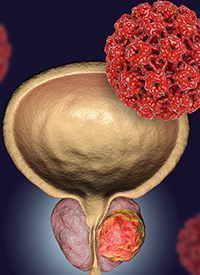Darolutamide Plus ADT Elicits OS Benefit in North American Patients With mHSPC
A subgroup analysis of the phase 3 ARASENS trial showed that darolutamide plus androgen deprivation therapy elicited an overall survival benefit in North American patients with metastatic hormone-sensitive prostate cancer.
Prostate Cancer | Image Credit: Dr_Microbe©

A subgroup analysis of the phase 3 ARASENS trial (NCT02799602) showed that darolutamide (Nubeqa) plus androgen deprivation therapy (ADT) elicited an overall survival (OS) benefit in North American patients with metastatic hormone-sensitive prostate cancer (mHSPC), according to data presented at the 2023 American Urological Association Annual Meeting.1
The triplet of darolutamide plus ADT/docetaxel reduced the risk of death by 41% vs ADT/docetaxel alone in the NA subgroup (HR, 0.59; 95% CI, 0.39-0.89). The 4-year OS rates were 65.9%% vs 49.6%, respectively. The median OS was not evaluable for the darolutamide arm vs 43.9 months for the placebo arm.
Of note, the analysis showed that the darolutamide OS benefit in Black/African American patients was consistent to the benefit observed in the overall study population.
“The favorable efficacy and safety of darolutamide plus ADT/docetaxel observed in NA patients and Black/African American patients, specifically, sets this combination as one of the new standards of care for mHSPC in these subgroups,” said lead author Neal Shore, MD, director of the Carolina Urologic Research Center, Atlantic Urology Clinics in Myrtle Beach, South Carolina.
The overall ARASENS trial (NCT02799602) population included 1305 patients with cytologically confirmed metastatic adenocarcinoma of the prostate who had an ECOG performance status of 0 or 1, and had adequate organ function. Patients were randomized 1:1 to either 600 mg of daily darolutamide (n = 651) or matched placebo (n = 654) plus ADT/docetaxel.
Patient characteristics were well balanced between the 2 study arms. The median age was 67 years for both the darolutamide and placebo groups and most patients had a Gleason score of 8 or greater (77.6% vs 78.9%, respectively) and M1 stage (85.7% vs 86.5%) at initial diagnosis. At initial screening, patients in both groups were most likely to have M1b stage disease (79.4% vs 79.5%) and ALP levels equal to or above the upper limit of normal (55.5% each).
The results in the overall study population showed that at a median follow-up of 43.7 months for darolutamide plus ADT/docetaxel and 42.4 months with placebo plus ADT/docetaxel, the active therapy resulted in a 32.5% reduction in the risk of death (HR, 0.68; 95% CI, 0.57-0.80; P <.001).2,3
Of the overall study population, the NA subgroup consisted of 244 patients (18.7%), comprising 218 patients in the United States and 26 patients in Canada. Of these patients, 36 (14.8%) were Black/African American.
Randomization of NA patients was 125 to the darolutamide arm and 119 to the placebo arm. In the NA population, baseline characteristics were well balanced between the darolutamide and control arms, with 2 exceptions. The rate of patients with an ECOG performance status of 0 was higher in the darolutamide arm at 76.8% vs 67.2% in the control arm, and the proportion of patients with de novo metastatic disease was lower in the darolutamide arm at 72.8% vs 79.0%, respectively.
Shore added that the baseline characteristics in the NA population as a whole were similar to those in the overall population. However, the proportion of patients with de novo metastatic disease was 86.1% in the overall population vs 75.8% in the NA population. Additionally, the baseline PSA levels were lower in the NA sub-population vs the overall population. In the darolutamide arm of the sub-population, the median PSA at baseline was 13.7 μg/L vs 30.3 μg/L in the darolutamide cohort of the overall population. The median PSAs were 9.2 μg/L vs 24.2 μg/L in the control arms of the sub-analysis and the overall study, respectively.
In addition to the OS boost, the investigators found that the addition of darolutamide to ADT/docetaxel reduced the risk of transitioning from mHSPC to castration-resistant prostate cancer (CRPC) by 68% vs ADT/docetaxel alone (HR, 0.32; 95% CI, 0.21-0.48). The median time to CRPC was not evaluable in the darolutamide arm vs 16.9 months in the placebo plus ADT/docetaxel arm. This same benefit in time to CRPC was observed in the group of Black/African American patients enrolled in the trial.
Regarding safety, Shore said that the overall incidence of treatment-emergent adverse events (TEAEs) was generally similar between treatment groups in the NA sub-population, and that the rates of grade 3-5 TEAEs were similar between treatment groups in the NA sub-population and the total study population. Among patients receiving darolutamide, the rates were 66.4% and 70.2%, in the NA sub-population and total populations, respectively, and in the controls arms, the rate was 67.5% in both the NA-subpopulation and total population.
Based on the overall study results of the ARASENS trial, the FDA approved darolutamide in August 2022 for use in combination with docetaxel for the treatment of patients with mHSPC.
References
1. Shore ND, Tombal B, Hussain M, et al. Efficacy and safety of darolutamide in combination with androgen-deprivation therapy and docetaxel in the North American population from ARASENS. Presented at 2023 AUA Annual Meeting. April 27-May 1; Chicago, IL. Abstract MP29-02. doi: 10.1097/JU.0000000000003257.02
2. Smith MR, Hussain MHA, Saad F, et al. Overall survival with darolutamide versus placebo in combination with androgen-deprivation therapy and docetaxel for metastatic hormone-sensitive prostate cancer in the phase 3 ARASENS trial. J Clin Oncol. 2022;40(suppl 6):abstr 13. doi: 10.1200/JCO.2022.40.6_suppl.013
3. Smith MR, Hussain MHA, Saad F, et al. Darolutamide and survival in metastatic, hormone-sensitive prostate cancer. N Engl J Med. Published online February 17, 2022. doi: 10.1056/NEJMoa2119115



